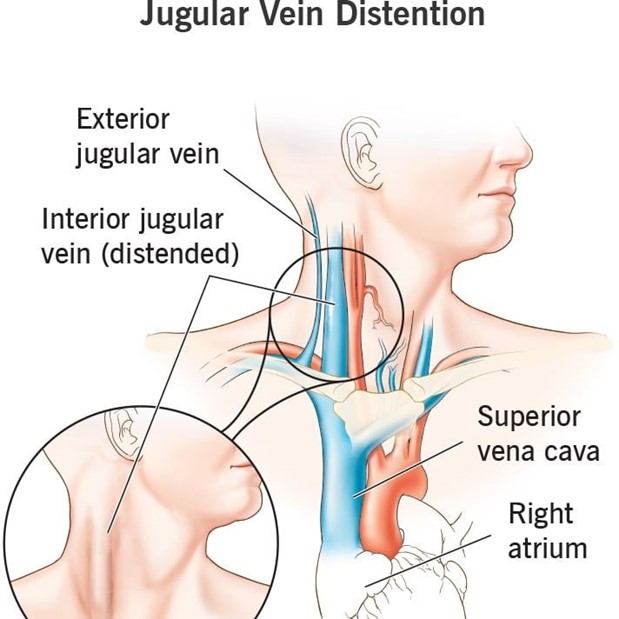A postoperative patient is diagnosed with fluid volume overload. What should the nurse expect to assess in this patient?
Concentrated hemoglobin and hematocrit levels
Distended neck veins
Decreased urine output
Poor skin turgor
The Correct Answer is B
Choice A: Concentrated hemoglobin and hematocrit levels are not a sign of fluid volume overload, but rather of fluid volume deficit. This is a condition that occurs when the body loses more fluid than it gains. This can happen in patients who have excessive bleeding, vomiting, diarrhea, or diaphoresis. Concentrated hemoglobin and hematocrit levels indicate hemoconcentration, which is an increase in the ratio of blood cells to plasma.
Choice B: Distended neck veins are a sign of fluid volume overload, because this condition occurs when the body retains more fluid than it excretes. This can happen in patients who have heart failure, kidney failure, or excessive fluid intake. Distended neck veins indicate increased central venous pressure, which is a measure of the pressure in the right atrium of the heart.
Choice C: Decreased urine output is not a sign of fluid volume overload, but rather of oliguria or anuria. These are conditions that occur when the urine output is less than 400 mL or 50 mL per day, respectively. These can happen in patients who have acute or chronic kidney injury, urinary obstruction, or shock. Decreased urine output indicates impaired renal function and decreased glomerular filtration rate.
Choice D: Poor skin turgor is not a sign of fluid volume overload, but rather of dehydration. This is a condition that occurs when the body loses more water than it gains. This can happen in patients who have fever, diabetes insipidus, or hyperglycemia. Poor skin turgor indicates decreased skin elasticity and delayed return to normal shape after being pinched.

Nursing Test Bank
Naxlex Comprehensive Predictor Exams
Related Questions
Correct Answer is ["A","D","E"]
Explanation
Choice A: Limit intake of canned soups is correct because canned soups are high in sodium and can increase blood
pressure and fluid retention. The nurse should advise the client to choose low-sodium or homemade soups instead.
Choice B: Choose botled salad dressings is incorrect because botled salad dressings are also high in sodium and can have added sugars and fats. The nurse should advise the client to make their own salad dressings with vinegar, oil, herbs, and spices.
Choice C: Choose diet sodas over botled water is incorrect because diet sodas are not a healthy alternative to water. Diet sodas contain artificial sweeteners, caffeine, and phosphoric acid, which can affect the body's pH balance and calcium absorption. The nurse should advise the client to drink plain water or flavored water with natural ingredients.
Choice D: Replace processed meats with fresh meat products is correct because processed meats such as bacon, ham, sausage, and hot dogs are high in sodium and preservatives. The nurse should advise the client to choose fresh meat products such as chicken, turkey, fish, or lean beef.
Choice E: Read labels on foods before eating is correct because reading labels can help the client identify the sodium content and other ingredients in foods. The nurse should advise the client to look for foods that have less than 140 mg of sodium per serving and avoid foods that have salt, sodium, or monosodium glutamate (MSG) in the ingredient list.
Correct Answer is ["A","B","C","D"]
Explanation
Choice A: Contraction of the facial muscle is correct. This is a sign of **Chvostek's sign**, which is a positive indicator of hypocalcemia. Chvostek's sign is elicited by tapping the facial nerve in front of the ear and observing for twitching of the facial muscles.
Choice B: Asked when the foot numbness would go away is correct. This is a sign of **paresthesia**, which is a sensation of numbness, tingling, or prickling in the extremities. Paresthesia is caused by decreased nerve function due to low calcium levels.
Choice C: Carpal spasm with blood pressure measurement is correct. This is a sign of **Trousseau's sign**, which is another positive indicator of hypocalcemia. Trousseau's sign is elicited by inflating a blood pressure cuff above the systolic pressure for 3 minutes and observing for carpal spasm.
Choice D: Complaints of fingers tingling is correct. This is another sign of paresthesia, as explained in choice B.
Choice E: Heart rate 88 and regular is incorrect. This is not a sign of hypocalcemia. Hypocalcemia can cause cardiac arrhythmias, such as prolonged QT interval, ventricular tachycardia, or cardiac arrest. A normal heart rate is between 60 and 100 beats per minute.
Whether you are a student looking to ace your exams or a practicing nurse seeking to enhance your expertise , our nursing education contents will empower you with the confidence and competence to make a difference in the lives of patients and become a respected leader in the healthcare field.
Visit Naxlex, invest in your future and unlock endless possibilities with our unparalleled nursing education contents today
Report Wrong Answer on the Current Question
Do you disagree with the answer? If yes, what is your expected answer? Explain.
Kindly be descriptive with the issue you are facing.
